Looking for ways to make your marketing more effective, professional, and consistent? Start by focusing on your core marketing assets.
Building out key marketing assets is an essential first step for any successful marketing campaign. You wouldn’t start working on the individual rooms of a house before the foundation was finished, would you? So don’t start building out your campaigns until you have foundational assets in place!
Marketing Assets 101
What are marketing assets? Simply put, they are resources that help you promote your brand. Marketing assets can take the shape of printed marketing materials, digital resources, or even human resources. There are foundational marketing assets that inform your overall marketing system, like a marketing strategy or messaging strategy. And then there are campaign or channel-specific marketing assets, like a social media strategy or social media accounts.
It’s generally advisable to start with foundational assets and build out from there, as they are the building blocks that make up a successful marketing campaign. The stronger your foundational assets, the more solid your structure will be. This structure will give shape to all of your campaigns and promotional materials and help ensure they are consistent and aligned with your business goals.
In the sections below, we’ll identify the most critical assets to start with and then share specific examples of each one so you can determine which to tackle yourself and where to seek support from professional marketing services.
7 Digital Marketing Assets Every Business Needs
Whether you’re just getting ready to launch your marketing or are in the process of auditing your existing marketing assets, we highly recommend starting with the seven foundational marketing assets highlighted below:
1. Ideal Customer Profile
One of the keys to successful marketing is having a clear understanding of who your ideal customers are so that you can target and speak directly to them. To make your ideal customers connect with your brand, you need to make them the hero of the stories you tell with your marketing. You need to understand not only who they are, but also their problems and goals for the future. That way, you can position your brand as a guide who will help them overcome their problems and experience a positive transformation. Ideally, before you get started on your messaging, branding, or any other marketing, you should dedicate time to customer profiling so that all of your marketing efforts can be customized and tailored. This will improve the quality of the leads you generate down the line.
2. Messaging Strategy
Once you have a clear understanding of your ideal customer, you can get to work on your messaging strategy, which is essentially your story. If your messaging tells a story, it will be easier for your customers to develop an emotional connection to your brand, which makes them more engaged and easy to convert. In fact, a recent study found that storytelling can boost conversion rates by 30%! Remember, your target customer should be the main character of this story. Writing a detailed messaging strategy will give your marketing team something to reference for each and every campaign they develop, thereby improving the consistency and effectiveness of your marketing efforts.
3. Branding Assets & Visual Brand Guide
Many businesses make the mistake of starting with a company name and logo. However, it’s actually better to start with your ideal customer profile and messaging strategy so that you can come up with a name that speaks to your target audience and branding assets that helps illustrate your story. That doesn’t mean your logo needs to be complex– keep it simple but choose a font and color palette that are attractive to your ideal customers. Workable logo files are an important asset that you will want to have easily accessible to your marketing team, as they will be applied to many different marketing channels and materials. A visual brand guide is another important asset that will ensure your marketing team knows how to apply your branding assets correctly and consistently.
4. Marketing Strategy & Plan
A marketing strategy defines your goals, and a marketing plan provides you with an actionable roadmap to achieve those goals. Think of the strategy as the “why” and the plan as the “how.” These core assets are essential to your business growth and will help you remain focused on your goals. In addition to an overarching marketing strategy and plan that tie all of your marketing campaigns together, it’s valuable to develop individual plans and strategies for each marketing channel, such as an SEO Strategic Plan, a Social Media Strategic Plan, etc.
5. Company Website
As of 2022, 71% of small to midsize businesses had their own website. Although a website will cost at least a few thousand dollars to build out, it’s a worthwhile investment, especially considering the vast majority of online shoppers today do online research before making a purchase. Having a professional website helps with brand authority and provides you with a tool for so many different digital marketing strategies, including website SEO, Google Ads, blog content, and much more. Keep in mind, your website copywriting should be informed by your messaging strategy and be visually consistent with your branding assets.
6. Sales Funnel
The marketing assets above will help attract leads, but what about those lukewarm leads that aren’t quite ready to make a purchase? That’s where a sales funnel comes into play. When done well, sales funnels will nurture and convert leads for you. Sales funnels can also help you build out a segmented email list, which is a valuable marketing asset in and of itself. Although sales funnels typically have a lot of moving parts and take time to set up, they can pretty much run on autopilot once they are launched. If you don’t have the time and skills needed to build a sales funnel from the ground up on your own, consider investing in a turnkey, done-for-you sales funnel. This is an investment with a high ROI that will quickly pay for itself.
7. Team of Experts
You can have all the marketing assets in the world, but your marketing efforts will fail to produce results if you don’t have a capable team to apply them. That’s why your marketing team is one of your most valuable marketing assets. Digital marketing is complex and ever-evolving, and different types of marketing require vastly different skills. For example, creating an effective sales funnel requires strategic thinking, creativity, web design, website copywriting, email design, email copywriting, and more. Because of this, it’s generally better to have a team of marketers supporting you rather than just one marketing person. This doesn’t mean you have to hire these people in-house— instead, you can invest in affordable yet professional marketing services from a team of specialists.
The essential marketing assets highlighted above work together and set the stage for all your marketing campaigns and promotional materials. Of course, there are many additional marketing assets and marketing materials that you’ll want to gather or produce along the way, including case studies, testimonials, imagery, blog content, social media accounts, a CRM, videos, an email list, crisis plans, compiled data, etc. But having the core assets in place from the start will make things so much easier. It’s like having all the ingredients for a recipe prepped and ready to go!
Marketing Assets Examples
Now that we’ve identified the most important marketing assets, let’s take a look at a few examples to get a better sense of how they look and work in practice.
Starting with an Ideal Customer Profile, this example succinctly describes the defining characteristics and values of the target customer. As you can see, this asset doesn’t have to be super in-depth; it’s actually best to keep it simple so that it’s easy for your team members to recall and quickly apply to every marketing campaign they work on.
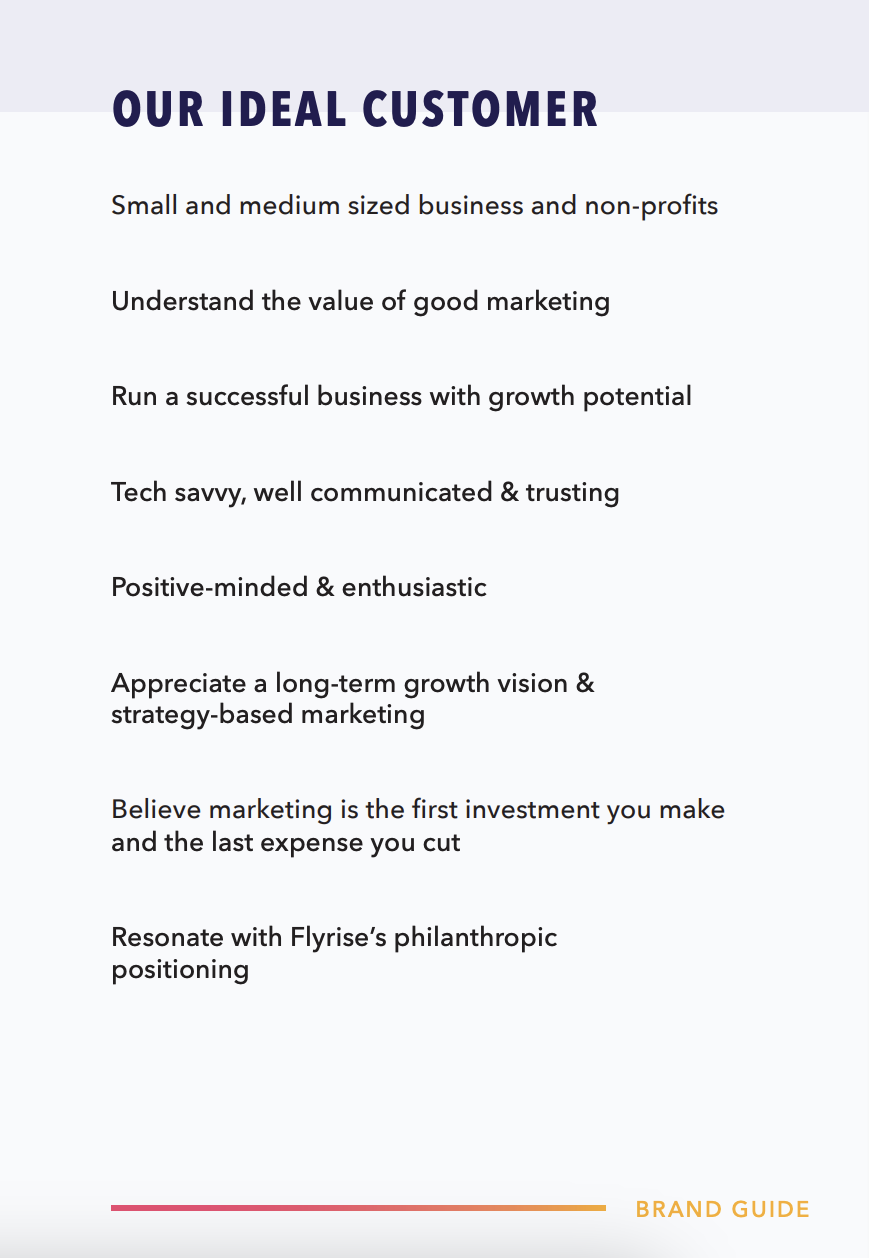
For a Visual Brand Guide, be sure to include all approved versions of your logo (primary and secondary, if applicable) and the specific colors in your brand color palette. It can be helpful to include examples of correct and incorrect logo usage and color palette applications as well. Other sections to include in a brand guide include a brand overview, brand fonts, photo usage, and anything else related to how your brand assets should or should not be used.
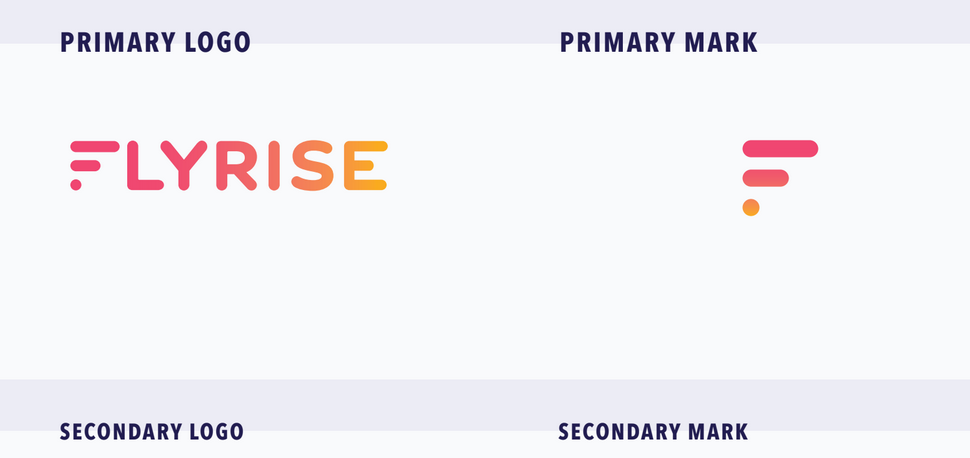

When building out a marketing strategy and plan, be sure to include specific KPIs (key performance indicators) to help you track your progress. These metrics should be hyper-specific to your business and marketing goals, but here’s an excerpt from a client marketing strategy to help get your ideas flowing:
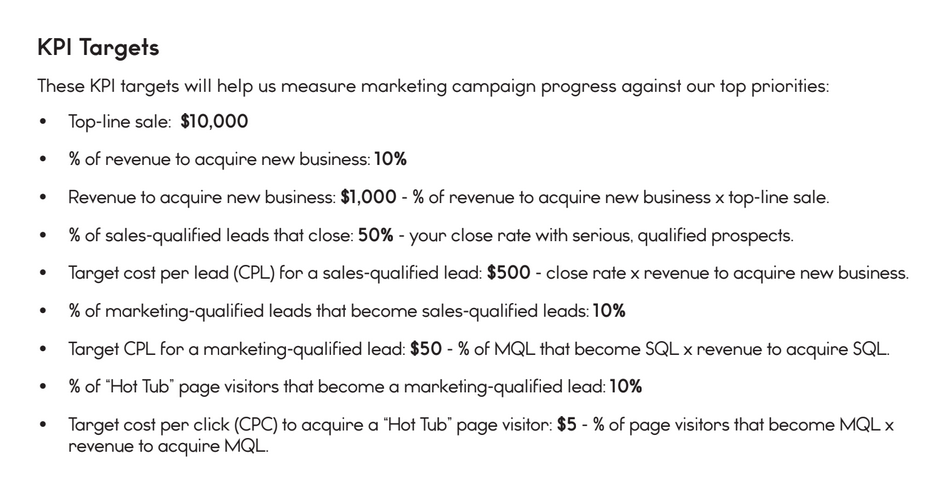
When it comes to designing and building a company website, the homepage is the most important page of all. Pay special attention to the content “above the fold,” meaning the content included in the top part of the page that is immediately visible to the viewer without having to scroll down. With just a quick scan, a website visitor should be able to clearly understand how your business can help them solve the problem they are facing. Your primary CTA, or Call to Action, should be obvious and attention-grabbing, as seen in the example below.
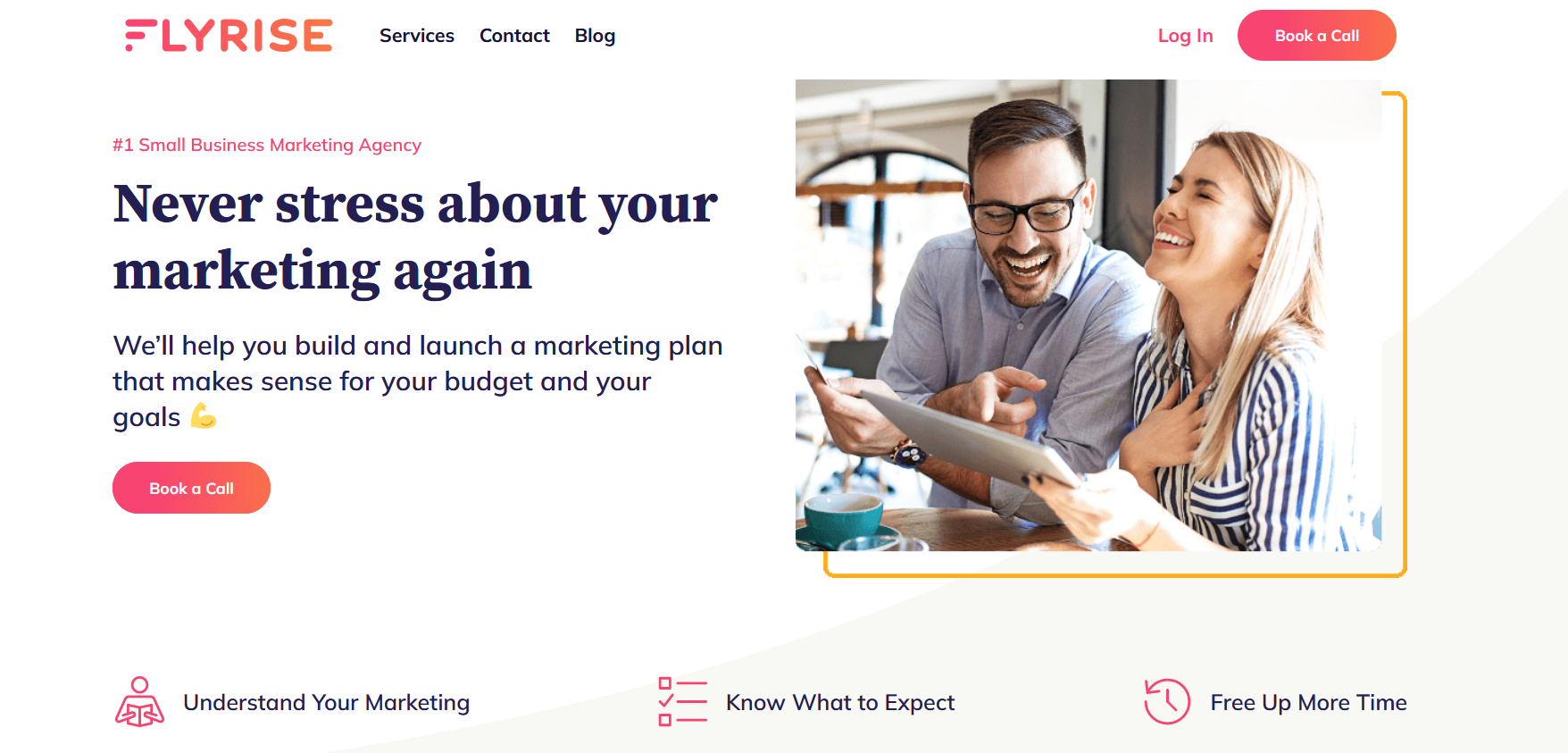
Sales funnels are not a one-size-fits-all marketing asset. On the contrary, they produce the best results when they are customized to target your ideal customers and mirror your typical sales cycle. Brainstorm how you can offer value and demonstrate your authority to incoming leads that aren’t quite ready to make a purchase. For example, our Flyrise sales funnel (seen below) delivers a PDF case study and then helps small businesses identify and overcome their greatest marketing challenge.
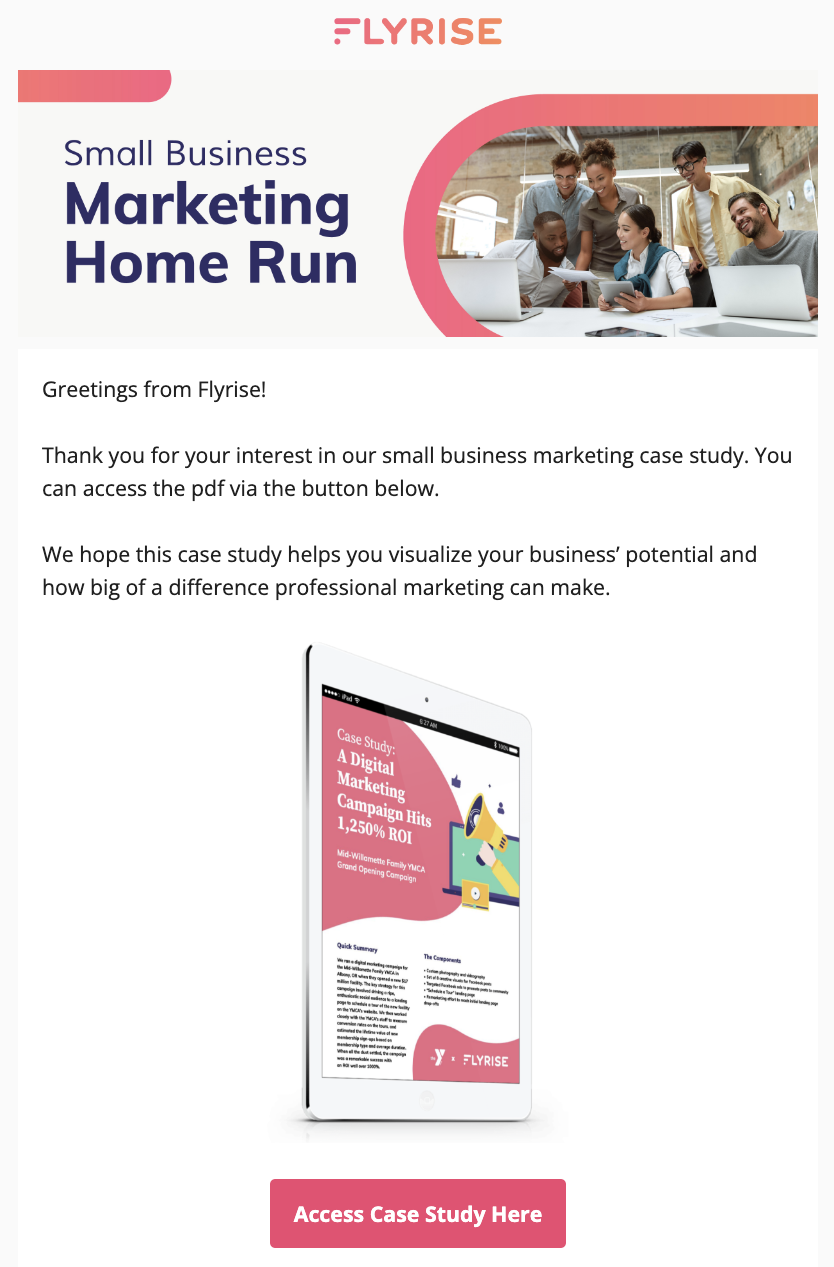
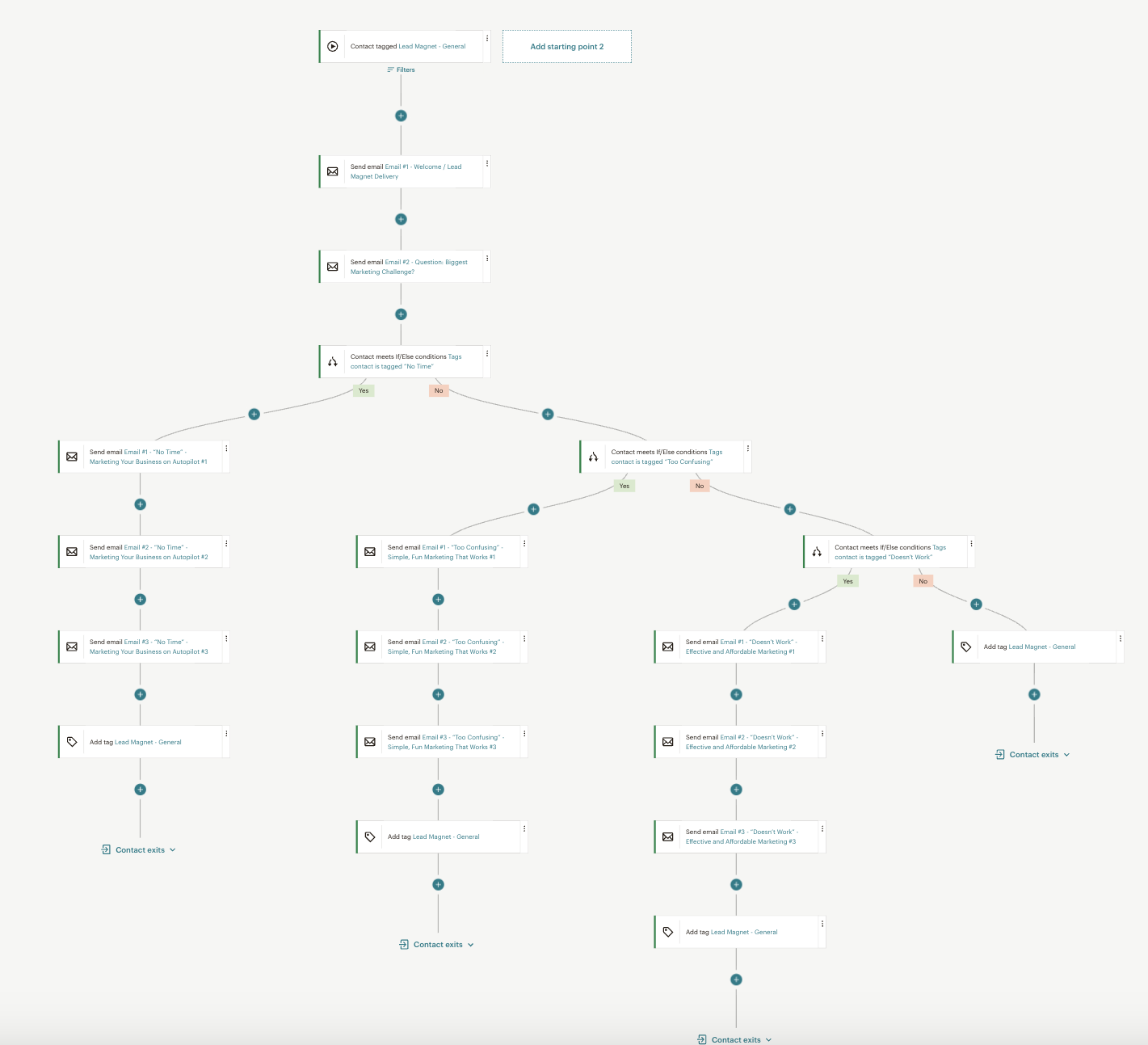
If you want more examples or need help creating any of the digital marketing assets identified in this blog post, we have a team of experienced marketers ready to help out!
How to Organize Marketing Assets
If you’re going to invest in developing great marketing assets, it’s worth investing a bit of time toward marketing asset management and organization. That way, you can actually find and use your assets when you need them. Marketing asset management is often broken down into four stages: creating assets, distributing assets, maintaining assets, and archiving assets. When your assets are easy to access and up to date, your marketing campaigns will be much more consistent and efficient.
Here are some tips for marketing asset organization:
- Standardize how you name your files
- Come up with a way to clearly indicate file statuses (current, archived, needs updating, etc.)
- Categorize your assets within folders and subfolders
- Archive files that are no longer in use
- Assign asset management and organization to a specific team member(s)
- Implement an asset management system
- Consider investing in marketing asset management technology, if you have the asset volume and usage to warrant it
Invest in New Marketing Assets with Flyrise
As mentioned above, a team of marketing experts is one of the most important marketing assets that a business can invest in. Experienced marketers will not only be able to build out foundational and channel-specific marketing assets to set you up for success, but also apply them to your campaigns consistently and effectively to generate results. Of course, most small and medium-sized businesses don’t have the resources to hire an in-house marketing team of their own. Fortunately, professional marketing services can help fill in the gaps!
Flyrise offers flexible and affordable digital marketing plans to meet the specific needs of any small or medium-sized business. Whether you’re simply looking for a few foundational assets to guide your team members or prefer to hand off all of your marketing to a team of professionals you can count on, we’re ready to help you grow and achieve your goals! Book a free consultation today to get started.
